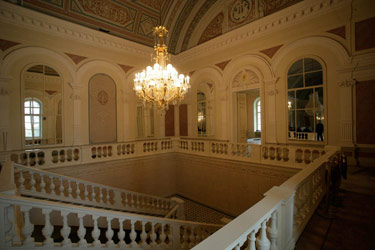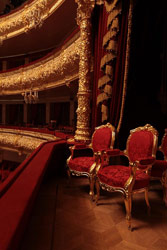
The Main Foyer.
Photo by Damir Yusupov |

The Main Foyer.
Photo by Damir Yusupov |

The Main Foyer.
Photo by Damir Yusupov |

Staircase to the Main Foyer.
Photo by Damir Yusupov |

Staircase to the Main Foyer.
Photo by Damir Yusupov |

The Main Foyer.
Photo by Damir Yusupov |

The Main Foyer. Staircase.
Photo by Damir Yusupov |

The Choral Hall.
Photo by Damir Yusupov |

The Choral Hall.
Photo by Damir Yusupov |

The Choral Hall.
Photo by Damir Yusupov |

The Choral Hall.
Photo by Damir Yusupov |

The Choral Hall.
Photo by Damir Yusupov |

The Round Hall.
Photo by Damir Yusupov |

Staircase at the dress-circle level. Fragment of old masonry.
Photo by Damir Yusupov |

Staircase at the fourth-circle level. Fragment of old masonry.
Photo by Damir Yusupov |

The Lobby.
Photo by Damir Yusupov |

The Central Box.
Photo by Damir Yusupov |

“Apollo and the Muses” plafond (fragment).Terpsichore.
Photo by Damir Yusupov |

Detail of the Auditorium decor.
Photo by Damir Yusupov |
The reconstruction and refurbishment of the Bolshoi Theatre Historic stage was a colossal, world-level project. The Theatre building has long been seen as one of Russia’s symbols. The Theatre’s rehabilitation, therefore, came under constant scrutiny from state authorities and public alike.
In 2009 to enhance coordination between project members, the President of Russia Dmitri Medvedev set up a special interdepartmental working group to control the pace of the reconstruction and refurbishment of the country’s chief Theatre. In July 2009 the Summa Capital investment group — Group founder Ziyavudin Magomedov is one of the Theatre’s trustees — was included in the reconstruction and refurbishment project. Having taken over from the main contractor, in a very short period of time Summa effected a substantial increase in the work pace.
The story of the reconstruction and refurbishment of the Bolshoi Theatre building dates back to virtually the first years of its existence. At the time the present reconstruction began from 50 to 70 percent of the building, according to different estimates, was in a precarious condition. Various renovation schemes were suggested: from a superficial overhaul to total reconstruction of the existing building. The project which was eventually chosen and approved by Theatre Company, architects, public figures in the arts etc., envisaged informed restoration of the Theatre’s public spaces and a cardinal reconstruction of the stagehouse, plus the addition of new, underground space. As a protected monument, moreover, the building’s historical appearance had to be preserved.
The first years of the project were devoted to a scrupulous examination of the building itself, the scanning of its position in space, the condition of its walls and foundations. And only in the autumn of 2009, after numerous preliminary studies, was the huge and badly dilapidated Bolshoi Theatre building transferred from temporary supports to a permanent foundation and large-scale restoration work initiated in the Theatre itself. In the two years that followed, record volumes of work were achieved in the renovation and reconstruction of the Theatre. Over three and a half thousand specialists worked at the Theatre each day, of which numbers upwards of a thousand were restorers. And another thousand labored in restoration workshops outside the Theatre.
In addition to the restoration of the Theatre’s historical appearance both inside and out, the project designers were also faced by the problem of providing it with extra working areas. This was successfully solved by the creation of additional underground space.
An equally important task was the necessity of combining meticulous restoration work in the Theatre’s public spaces with the installation of state-of-the-art technological equipment in the Theatre’s stagehouse and new spaces.
The Bolshoi has to a large extent reacquired its authentic historical appearance, lost during the years of Soviet power. The auditorium and part of its suite of halls now look as they were originally conceived by Bolshoi Theatre architect Alberto Cavos. While the former imperial foyer halls have been given back their 1895 decor, this was the year they were redecorated for Emperor Nicholas II’s coronation celebrations. Each reproduced or restored element of interior decoration was made the object of a special project for which separate documentation was collected based on numerous archival and on-site researches.
In 2010 the auditorium suite of halls were renovated: the Lobby, the Main or the White Foyer, the Choral, Exhibition, Round and Beethoven halls. Muscovites were able to admire the restored facades and the renovated symbol of the Bolshoi Theatre — the famous Apollo quadriga, created by the sculptor Peter Klodt.
The auditorium has regained its original beauty. And, just like the 19th century theatergoer, so each member of the public today will be dazzled by its extravagant and at the same time “light” décor. The bright crimson, scattered with gold, draping of the interiors of the boxes, the different on each level stucco arabesques, the Apollo and the Muses plafond — all this contributes to the auditorium’s breath-taking impact.
Special attention was paid to the restoration of the legendary acoustics. International experts did extensive research work and made sure all their technical recommendations were carried out to the letter.
State of the art machinery has been installed in the stagehouse. The Bolshoi Theatre Historic stage now consists of seven two-tier rising and descending platforms. These platforms can easily change their positions, thus the stage can become horizontal, raked or stepped. The stage and backstage area can be united which creates a stage space of incredible depth.
New upper stage equipment, remotely controlled by computer, makes it possible to derive maximum use from lighting, sound and visual effects. Cutting edge rigs have been installed for the deployment of lanterns, special effects apparatus and acoustics.
The orchestra pit has been provided with extra space under the forestage. This makes it one of the biggest orchestra pits in the world seating up to 130 musicians, which is necessary for the performance of such large-scale works as, for instance, Wagner operas.
The installation of state of the art stage equipment was a unique world-scale project. The reconstruction has doubled the Theatre’s total floor space. Thanks to the expansion of the Theatre’s existing underground spaces (under stagehouse) and to the construction of new underground space under Theatre Square, this has been achieved without any change to the Theatre’s external appearance.
Thus the Theatre has acquired badly needed new space, including an underground concert and rehearsal room, which has inherited its name from the Beethoven Hall, under the Theatre lobby. This hall is a multi-functional space which can be used in different ways. It consists of five main platforms: the central platform is the stage itself, two platforms to the right and left of it can be used either to increase the size of the stage or as audience space. The two remaining platforms form the main space of the auditorium. All of the platforms can be raised to foyer level to create a space for holding formal, receptions. Apart from this concert hall and its auxiliary premises, the rest of the underground space under Theatre Square accommodates a large number of technical, service and staff rooms.
The Bolshoi Theatre reconstruction project also included the renovation of the Khomyakov House, a protected architectural monument of the first half of the nineteenth century situated immediately behind the Bolshoi, which has been transformed into a service wing. Due to numerous 20th century reconstructions, the historical interiors of the Khomyakov House have been totally lost. While its main walls have been preserved, the interior layout has been redesigned to meet the Theatre’s present-day requirements. Thus the Khomaykov House, which is linked to the main Bolshoi Theatre building by an underground tunnel, is a key element in the gigantic Bolshoi Theatre complex.
The renovation of the country’s main stage was a landmark event in the lives of a large coordinated team of highest-level professionals. Participating in the project were uniquely qualified specialists whose great feat of labor will earn them the undying gratitude of present-day Bolshoi Theatre audiences.
Print page



